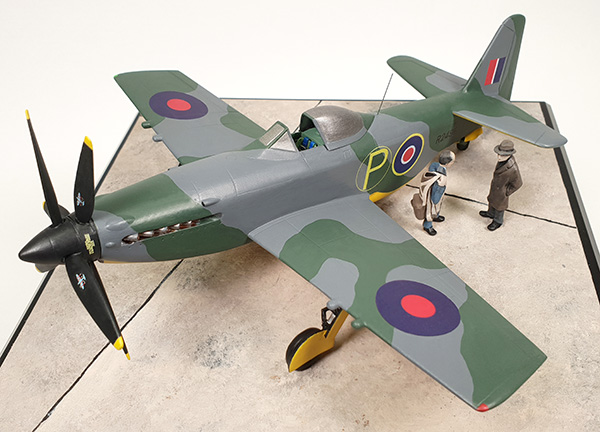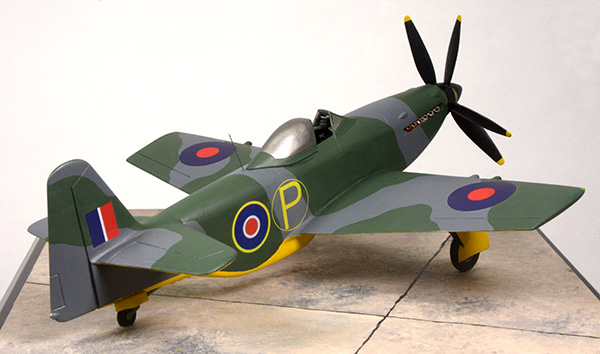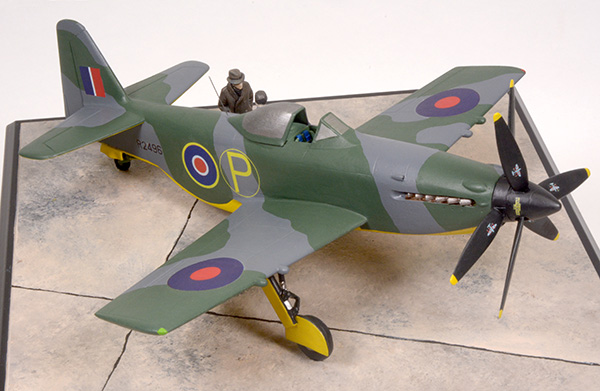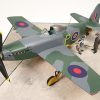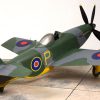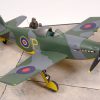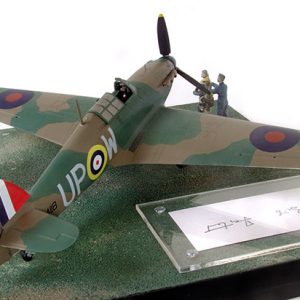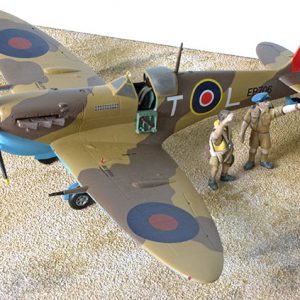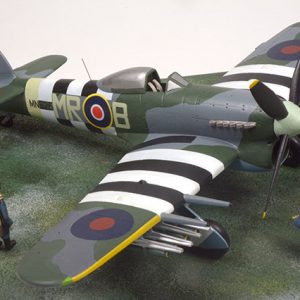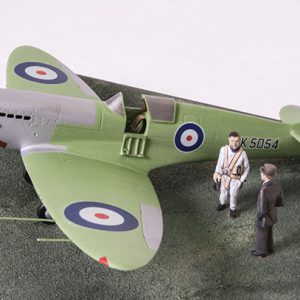Martin Baker MB5 R2496
Martin Baker and A.& A.E.E., James Martin, Sqn Ldr Jan Zurakowski,
Farnborough 1946.
“Martin’s Aircraft Works” was founded at Denham in Buckinghamshire by James Martin. A radical 1929 aircraft design proposed a three seat monoplane with with a 120HP Hermes engine set behind the cockpit with a long shaft driving a propeller in the nose. This was abandoned due to the economic climate of the time. On the 17th of August 1934 with the arrival of Captain Valentine Henry Baker and with financial help from Mr Francis Francis the Martin-Baker Aircraft Company was formed to continue the work of aircraft development. Their first aircraft the MB1 used the design patents for aircraft structures held by James Martin.
The MB1 was a two-seat, low-wing monoplane, with a closed cockpit, powered by a Napier Javelin series 3A, producing 160HP. The MB 1 had folding wings, and a fuselage of welded steel tubes, this method of fuselage construction became a common feature of Martin Baker aircraft. The MB1 made its first flight in the spring of 1935 piloted by Captain Valentine Baker.
Their first military design was the Martin Baker MB2, a Napier Dagger powered fighter that flew in 1938. It was a private venture to meet Air Ministry Specification F.5/34 for a fighter for service in the tropics. It featured a fixed trousered undercarriage and eight 0.303 machine guns. The MB2 made its maiden flight on August the 3rd 1938. It was tested but neither it nor other designs to F.5/34 were adopted.
Air Ministry specification F.18/39 for a potential successor to the Hurricane and Spitfire led to the MB 3. The MB 3 used a 2,000-hp, 24-cylinder Napier Sabre engine and was armed with no fewer than six 20 mm cannon in the wings. First flown on August the 31st 1942, and seemingly headed for production with a speed of 415 miles per hour, it appeared to be a world-beater. But less than two weeks after its first flight on September the 12th 1942 disaster struck. Making a dead-stick landing in a field after an aborted takeoff, the MB 3 crashed into a tree stump. The aircraft was demolished and Captain Valentine Baker lost his life.
Baker’s death prompted Martin’s decision to focus on pilot safety. Martin-Baker manufactured aircraft components, including armoured seats for Supermarine Spitfires. In the meantime, however, a modified aircraft based on the ill-fated MB 3 was taking shape. A modified MB 3 with a Rolls-Royce Griffon was planned as the MB 4, but a full redesign was chosen instead, the new aircraft became the Martin Baker MB5. The re-designed aircraft, used wings similar to the MB 3, but had an entirely new steel-tube fuselage. Power came from a Rolls-Royce Griffon 83 liquid-cooled V-12 engine, producing 2,340 hp (1,745 kW) and driving two three-bladed contra-rotating propellers. Armament was four 20 mm Hispano cannon, mounted in the wings outboard of the widely spaced retractable undercarriage. With a wingspan of exactly 35 feet, the MB 5 had a gross weight of 12,090 pounds. The MB 3 had been designed to enable a mechanic with only a little training to service it, and this remained a goal with the Martin Baker MB5. Martin decided on a bubble canopy and improved the pilot’s visibility by moving the cockpit forward five feet. It was built under the same contract that covered the building of the MB.3.
Martin, now the sole figure responsible for the aircraft, was a perfectionist, and the construction of the Martin Baker MB5 began to take longer than planned. The scheduled delivery date of January 1st 1943 slipped repeatedly. The first-flight took place on May the 23rd 1944 with Bryan Greensted, chief test pilot for propeller manufacturer Rotol, at the controls. The initial flight revealed a lack of straight line stability. This was resolved by increasing the size of the vertical tail and rudder. Further modifications took place and, after one of the subsequent flights, Greensted said the MB 5 was “a super ship to fly” and “earns the respect of everyone associated with it.” It was considered extremely stable as a gun platform yet highly manoeuvrable for dogfighting, qualities that are difficult to combine. The MB 5’s top speed was 460 mph at 20,000 feet, with an initial climb rate of 3,800 feet per minute and a service ceiling of 40,000 feet. Its range was calculated to be in excess of 1,000 miles.
The aircraft resumed flying near the end of the war in Europe and went to the RAF’s Armament Experimental Establishment at Boscombe Down for official trials in February 1946. By the time a serious flight-test program was under way, the war had already ended.
Serial production, had it been authorised, would have begun in time for squadron service over Germany. Instead, the RAF directed their attention towards jet-powered fighters and the MB 5 remained unordered. Perhaps one of the reasons that the Martin Baker MB5 did not go into production, was because the Rolls-Royce Griffon engine failed when the MB 5 was being demonstrated to Prime Minister, Winston Churchill, the Chief of the Air Staff and a host of other VIPs at an important display of British and captured German aircraft at Farnborough
Although the Martin Baker MB5 performed poorly during the demonstration for Winston Churchill, it enjoyed its grandest moment at the 1946 Farnborough trade show, where Polish aerobatic and display pilot Squadron Leader Jan Zurakowski put the plane through its paces before an enthralled audience. Zurakowski, as quoted in a Rolls-Royce publication, said the Martin Baker MB5 was “the best airplane I have ever flown … better in many ways than the Spitfire.” Another pilot said it offered “steady flight behavior, good control and an excellent view.”
The MB 5 was one of several top-performing, propeller-driven fighters that came along at the end of World War II. Others included the Boeing XF8B-1, Republic XP-72, Supermarine Spiteful, and the Focke-Wulf Ta 152. There was a simple reason they became sidelined – the jet engine. The MB5 was an outstanding aircraft but arrived too late, relying on yesterday’s technology.
Consideration was given after the war to an attempt on the world speed record, and trials from the Rotol airfield at Staverton recorded a speed of 484 mph. As with its potential service, this plan was overtaken by the jet, with the RAF setting up an attempt with the Meteors of its High Speed Flight that achieved a speed of 606 mph.
Royal Navy Capt. Eric “Winkle” Brown called the MB 5 “most magnificent” and said it should have been placed into production. “In my opinion this is an outstanding aircraft, particularly when regarded in the light of the fact that it made its maiden flight as early as 23rd May 1944”
Ironically, when the Korean War began the standard U.S. fighter in the region, by now re-named the F-80, proved too fast to combat North Korean propeller-driven fighters, and 145 Mustangs, now called F-51s, had to be rushed across the Pacific to join the fight with Seafires and Sea Furies from the Royal Navy. Propeller aircraft excelled in Korea, and the Martin Baker MB5 would have been perfect for conditions there.
But by then the only Martin Baker MB5 built was no longer in existence. After its flying was finished its engine was removed, and the airframe was used for training at RAF Wattisham, Suffolk, in the late 1940s. The aircraft, which would have made a superb museum display, was reputedly destroyed on a gunnery range and then burned.
In 1944 Martin-Baker was approached by the Ministry of Aircraft Production to investigate ejection systems enabling pilots to bail out safely from high-speed fighter aircraft. They are now world leaders in ejection seat technology and have saved the lives of thousands of pilots across the world.


